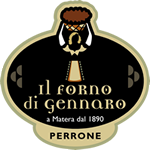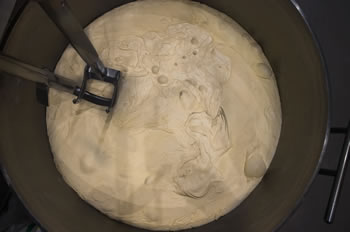Matera bread is only made of re-milled durum wheat semolina through an artisanal process. It is characterized by the yellow color of the crumb and the brown breadcrust witch is crunchy and tasty. It has a high porosity with dimensions of the alveolation ranging from a few millimeters to several centimetres. It is a bread with an unmistakable smell and taste, it comes in sizes of 1/4, 1/2, 1 and 2 kg, in the shape of a cornetto shape or in the panella shape, also called tall bread.
Anyone who has tasted Matera bread has certainly not forgotten the unique and unmistakable taste of an Italian handcrafted product. The bread of the Forno di Gennaro is produced only with re-milled durum wheat semolina from the Lucanian area, it is the resoult of an ancient culture and a tradition that is still alive and in evolution. The bread of Matera has always been the symbol of the city, a central and indispensable element of the life of the population, considered as a sacred meal >> buy online
Matera bread
Matera bread produced buy the Forno di Gennaro
The two-arm mixer kneads for about an hour, the mass obtained rests in the steel tub for another hour during which theIn the Forno di Gennaro the bread making process is an artisanal process carried out with the help of machinery that helps man in the heaviest processes. The baking begins in the early hours of the night; water and the sourdough obtained by reviving the sourdough preserved from the previous day’s dough are added to the re-milled durum wheat semolina.
The two-arm mixer kneads for about an hour, the mass obtained rests in the steel tank for another hour during which the dough begins its leavening process. During this period of time the bakers prepare the other special doughs of wholemeal flours or to make cornetto (typical Italian bread), taralli, friselle, sweet bread, milk bread and the many other baked products that the Forno di Gennaro offers fresh to its customers every day.
When the first bubbles begin to appear in the dough, the dough is "lifted" into pieces and placed on the table where the mass is broken up manually into what will later become the loaves of bread. These pieces cut from the large mass of dough undergo an initial processing by being transformed into spherical loaves which are deposited on cotton cloths inside wooden crates in which they will finish the natural leavening for the rest of the night.
just before eight in the morning, the loaves, which have in the meantime have completely finished the leavening process, are shaped into various shapes and sizes that generally range from a kilo to a quarter of a kilo. It is in this phase more than in others that the dexterity and wisdom of the bakers intervene. After having cleaned the base of the oven from the residues of burning wood, with very fast and always the same movements the bakers shape the mass transforming it into real works of art which can be considered the shapes of the Bread of Matera. Although there is a "clock" (as it is called by bakers) which measures the temperature of the oven, it is the color inside which determines the right time to bake.
In a few minutes the masters give shape to three, even four quintals of pasta; the loaves are ordered on the oven floor where they will cook for about two hours. The bread thus baked arrives hot in the adjacent sales point which from the early hours of the morning is filled with demanding customers who are attentive to ensuring that the tradition of Matera bread is respected and perpetrated.
>> buy online the bread of Matera


 Home
Home


















 Sito Italiano
Sito Italiano